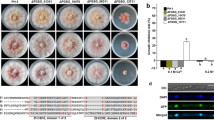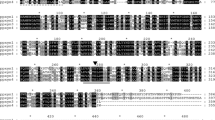Abstract
Gibberella zeae causes Fusarium head blight of cereal crops, and sexual spores of the fungus play an important role as primary inocula. We isolated a restriction enzyme-mediated integration (REMI) transformant, ZH431, of G. zeae with defects in perithecia formation and virulence. Integration of the REMI vector resulted in disruption of GzCHS7 gene, which encodes a putative class VII chitin synthase with high similarity to Fusarium oxysporum ChsVb. A second chitin synthase, GzCHS5, is adjacently located in a head-to-head configuration with GzCHS7, and its deduced protein sequence showed similarity with a class V chitin synthase in F. oxysporum. Neither ΔGzChs5 nor ΔGzChs7 mutants produced perithecia or caused disease on barley heads. Microscopic observation revealed that both mutants formed balloon-shaped hyphae and intrahyphal hyphae and that cell wall rigidity of the mutants was weaker than that of the wild-type strain. Transcription profiles of GzCHS5 and GzCHS7 were not altered in ΔGzChs7 and ΔGzChs5, respectively, suggesting that transcription regulations of the genes are independent of each other. Our results demonstrate that GzCHS5 and GzCHS7 are indispensable for perithecia formation and pathogenicity as well as normal septa formation and hyphal growth in G. zeae.








Similar content being viewed by others
References
Asiegbu FO, Choi W, Jeong JS, Dean RA (2004) Cloning, sequencing and functional analysis of Magnaporthe grisea MVP1 gene, a hex-1 homolog encoding a putative ‘woronin body’ protein. FEMS Microbiol Lett 230:85–90
Bartnicki-Garcia S (1968) Cell wall chemistry, morphogenesis, and taxonomy of fungi. Annu Rev Microbiol 22:87–108
Capellini RA, Peterson JL (1965) Macroconidium formation in submerged cultures by a nonsporulating strain of Gibberella zeae. Mycologia 57:962–966
Culp DW, Dodge CL, Miao Y, Li L, Sag-Ozkal D, Borgia PT (2000) The chsA gene from Aspergillus nidulans is necessary for maximal condition. FEMS Microbiol Lett 182:349–353
Desjardins AE (2006) Fusarium mycotoxins chemistry. Genetics, and biology. American Phytopathological Society, St Paul
Dufresne M, Perfect S, Pellier AL, Bailey JA, Langin T (2000) A Gal4-like protein is involved in the switch between biotrophic and necrotrophic phases of the infection process of Colletotrichum lindemuthianum on common bean. Plant Cell 12:1597–1590
Han YK, Lee T, Han KH, Yun SH, Lee YW (2004) Functional analysis of the homoserine O-acetyltransferase gene and its identification as a selectable marker in Gibberella zeae. Curr Genet 46:205–212
Han YK, Kim MD, Lee SH, Yun SH, Lee YW (2007) A novel F-box protein involved in sexual development and pathogenesis in Gibberella zeae. Mol Microbiol 63:768–779
Hardham AR (2001) Cell biology of fungal infection of plants. In: Gow NAR, Howard RJ (eds) The mycota VIII. Springer, Berlin, pp 91–123
Horiuchi H, Fujiwara M, Yamashita S, Ohta A, Takagi M (1999) Proliferation of intrahyphal hyphae caused by disruption of csmA, which encodes a class V chitin synthase with a myosin motor-like domain in Aspergillus nidulans. J Bacteriol 181:3721–3729
Horwitz BA, Sharon A, Lu SW, Ritter V, Sandrock TM, Yoder OC, Turgeon BG (1999) A G protein α subunit from Cochliobolus heterostrophus involved in mating and appressorium formation. Fungal Genet Biol 26:19–32
Hou Z, Xue C, Peng Y, Katan T, Kistler HC, Xu JR (2002) A mitogen-activated protein kinase gene (MGV1) in Fusarium graminearum is required for female fertility, heterokaryon formation, and plant infection. Mol Plant Microbe Interact 15:1119–1127
Ichinomiya M, Yamada E, Yamashita S, Ohta A, Horiuchi H (2005) Class I and class II chitin synthases are involved in septum formation in the filamentous fungus Aspergillus nidulans. Eukaryot Cell 4:1125–1136
Inoue I, Namiki F, Tsuge T (2002) Plant colonization by the vascular wilt fungus Fusarium oxysporum requires FOW1, a gene encoding a mitochondrial protein. Plant Cell 14:1869–1883
Lee J, Lee T, Lee YW, Yun SH, Turgeon BG (2003) Shifting fungal reproductive mode by manipulation of mating type genes: obligatory heterothallism of Gibberella zeae. Mol Microbiol 50:145–152
Lee SH, Lee J, Lee S, Park EH, Kim KW, Kim MD, Yun SH, Lee YW (2009) GzSNF1 is required for normal sexual and asexual development in the ascomycete Gibberella zeae. Eukaryot Cell 8:116–127
Leslie JF, Summerell BA (2006) The Fusarium lab manual. Blackwell, Ames
Li FB, Thompson GE, Newman RC (1998) Force modulation atomic force microscopy: background, development and application to electrodeposited cerium oxide films. Appl Surf Sci 126:21–33
Li HP, Fu CY, Peschen D, Ling XY, Fischer R, Liao YC (2003) Cloning and characterization of a gene coding for a class I chitin synthase from Fusarium graminearum. Can J Plant Pathol 25:240–248
Liu HB, Kauffman S, Becker JM, Szaniszlo PJ (2004) Wangiella (Exophiala) dermatitidis WdChs5p, a class V chitin synthase, is essential for sustained cell growth at temperature of infection. Eukaryot Cell 3:40–51
Lu S, Lyngholm L, Yang G, Bronson C, Yoder OD, Turgeon BG (1994) Tagged mutations at the Tox1 locus of Cochliobolous heterostrophus by restriction enzyme-mediated integration. Proc Natl Acad Sci USA 91:12649–12653
Madrid MP, Di Peitro A, Roncero MIG (2003) Class V chitin synthase determines pathogenesis in the vascular wilt fungus Fusarium oxysporum and mediates resistance to plant defense compounds. Mol Microbiol 47:257–266
Mandel MA, Galgiani JN, Kroken S, Orbach MJ (2006) Coccidioides posadasii contains single chitin synthase genes corresponding to classes I to VII. Fungal Genet Biol 43:775–788
Martín-Urdíroz M, Madrid MP, Roncero MIG (2004) Role of chitin synthase genes in Fusarium oxysporum. Microbiology 150:3175–3187
Martín-Urdíroz M, Roncero MIG, Gonzalez-Reyes JA, Ruiz-Roldan C (2008) ChsVb, a class VII Chitin synthase involved in septation, is critical for pathogenicity in Fusarium oxysporum. Eukaryot Cell 7:112–121
Motoyama T, Kojima N, Horiuchi H, Otha A, Takagi M (1994) Isolation of a chitin synthase gene chsV of Aspergillus nidulans. Biosci Biotechnol Biochem 58:2254–2257
Motoyama T, Fujiwara M, Kojima N, Horiuchi H, Otha A, Gakagi M (1996) The Aspergillus nidulans genes chsA and chsD encode chitin synthases which have redundant functions in conidia formation. Mol Gen Genet 251:520–528
Namiki F, Matsunaga M, Okuda M, Inoue I, Nishi K, Fujita Y, Tsuge T (2001) Mutation of an arginine biosynthesis gene causes reduced pathogenicity in Fusarium oxysporum f. sp. melonis. Mol Plant Microbe Interact 14:580–584
Nino-Vega GA, Carrero L, San-Blas G (2004) Isolation of the CHS4 gene of Paracoccidioides brasiliensis and its accommodation in a new class of chitin synthases. Med Mycol 42:51–57
Sambrook J, Russell DW (2001) Molecular cloning: a laboratory manual. Cold Spring Harbor Laboratory Press, Cold Spring Harbor
Shim WB, Sagaram US, Choi YE, Wilkinson HH, Lee YW (2006) FSR1 is essential for virulence and female fertility in Fusarium verticillioides and F. graminearum. Mol Plant Microbe Interact 19:725–733
Sutton JC (1982) Epidemiology of wheat head blight and maize ear rot caused by Fusarium graminearum. Can J Plant Pathol 4:195–209
Takeshita N, Yamashita S, Ohta A, Horiuchi H (2002) csmA, a gene encoding a class V chitin synthase with a myosin motor-like domain of Aspergillus nidulans, is translated as a single polypeptide and regulated in response to osmotic conditions. Biochem Biophys Res Commun 298:103–109
Takeshita N, Yamashita S, Ohta A, Horiuchi H (2006) Aspergillus nidulans class V and VI chitin synthases CsmA and CsmB, each with a myosin motor-like domain, perform compensatory functions that are essential for hyphal tip growth. Mol Microbiol 59:1380–1394
Trail F, Common R (2000) Perithecial development by Gibberella zeae: a light microscopy study. Mycologia 92:130–138
Trail F, Xu H, Lorganger R, Gadoury D (2002) Physiological and environmental aspects of ascospore discharge in Gibberella zeae. Mycologia 94:181–189
Trail F, Gaffoor I, Vogel S (2005) Ejection mechanics and trajectory of the ascospores of Gibberella zeae (anamorph Fusarium graminearum). Fungal Genet Biol 42:528–533
Urban M, Mott E, Farley T, Hammond-Kosack K (2003) The Fusarium graminearum MAP1 gene is essential for pathogenicity and development of perithecia. Mol Plant Pathol 4:347–359
Weber I, Assmann D, Thines E, Steinberg G (2006) Polar localizing class V myosin chitin synthases are essential during early plant infection in the plant pathogenic fungus Ustilago maydis. Plant Cell 18:225–242
Werner S, Sugui JA, Steinberg G, Deising HB (2007) A chitin synthase with a myosin-like motor domain is essential for hyphal growth, appressorium differentiation, and pathogenicity of the maize anthracnose fungus Collectotrichum graminicola. Mol Plant Microbe Interact 12:1555–1567
Yu JH, Hamari Z, Han KH, Seo JA, Reyes-Dominguez Y, Scazzocchio C (2004) Double-joint PCR: a PCR-based molecular tool for gene manipulations in filamentous fungi. Fungal Genet Biol 41:973–981
Yu HY, Seo JA, Kim JE, Han KH, Shim WB, Yun SH, Lee YW (2008) Functional analyses of heterotrimeric G protein Gα and Gβ subunits in Gibberella zeae. Microbiology 154:392–401
Acknowledgments
This work was supported by a grant CG1411 from the Crop Functional Genomics Center of the twenty-first century Frontier Research Program funded by the Korean Ministry of Education, Science and Technology, and by the Korea Science and Engineering Foundation (KOSEF) grant by the Korea government (R11-2008-062-01001-0).
Author information
Authors and Affiliations
Corresponding author
Additional information
Communicated by S. Hohmann.
Rights and permissions
About this article
Cite this article
Kim, JE., Lee, HJ., Lee, J. et al. Gibberella zeae chitin synthase genes, GzCHS5 and GzCHS7, are required for hyphal growth, perithecia formation, and pathogenicity. Curr Genet 55, 449–459 (2009). https://doi.org/10.1007/s00294-009-0258-6
Received:
Revised:
Accepted:
Published:
Issue Date:
DOI: https://doi.org/10.1007/s00294-009-0258-6




